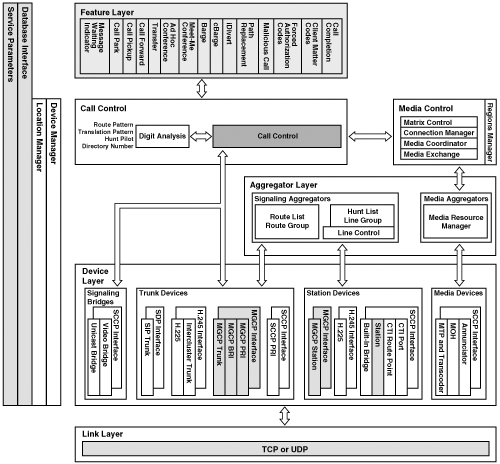Call Detail Records
Cisco CallManager produces two types of records which store call history and diagnostic information, as follows:
- Call detail records (CDR) Data records that contain information about each call that was processed by CallManager.
- Call management records (CMR) Data records that contain quality of service (QoS) or diagnostic information about the call. Also referred to as diagnostic records.
Both CDRs and CMRs together are referred to as CDR data. CDR data provides a record of all calls that have been made or received by users of the CallManager system. CDR data is useful primarily for generating billing records; however, it can also be used for tracking call activity, diagnosing certain types of problems, capacity planning, and evaluating the QoS of calls through the system.
This chapter includes a general overview of the CDR facilities provided in release 4.1 of CallManager. Most of this information applies to earlier versions of CallManager, too. The first three sections give a general understanding of the CDR data, the facilities provided for controlling the generation and usage of the data, and a description of what happens to CDR data in failure scenarios. The first three sections are as follows:
- Overview of CDR Data
- Creation and Usage of CDR Data
- Storage and Maintenance of CDR Data
The remaining sections offer more detailed information that you'll find useful if you are writing or integrating post-processing packages for CDR data, or simply interested in the details. The remaining sections are as follows:
- Understanding Field Data in CDRs
- Understanding Field Data in CMRs
- Identifying CDR Data Generated for Each Call Type
- Accessing CDR Data in the Central CDR Database
- Hints on Processing CDR Data
- Troubleshooting CDR Data Generation and Storage
Figure 7-1 shows the block structure of CallManager. CDRs are generated in the Call Control Layer of CallManager. CMRs are generated in the Station and Media Gateway Control Protocol (MGCP) components within the Device Layer. The shaded blocks are the CallManager components that generate CDR data. You can learn more about the various blocks and layers of CallManager in Chapter 1, "Cisco CallManager Architecture."
Figure 7-1. CallManager Block Structure Diagram

Cisco CallManager Architecture
- Cisco CallManager Architecture
- Circuit-Switched Systems
- Enterprise Deployment of CallManager Clusters
- Regions
- Summary
Call Routing
- Call Routing
- The Three Responsibilities of Call Routing
- The Seven Fundamentals of Call Routing
- Route Patterns and Route Filters
- Dialing Transformations
- Translation Patterns
- Call Hunting Constructs
- Calling Search Spaces and Partitions
- Case Studies
- Miscellaneous Solutions
- International Numbering Plans
- Troubleshooting
- Summary
Station Devices
- Station Devices
- Definition of Station Devices
- Overview of Station Device Features Supported by CallManager
- Overview of Station Devices Supported by CallManager
- SCCP Station Devices
- Cisco VT Advantage
- Computer Telephony Interface (CTI) Devices
- H.323 Endpoint Devices
- Summary
Trunk Devices
- Trunk Devices
- Architectural Overview of Trunk Devices
- Overview of Circuit-Switched Interfaces
- VoIP Gateway Security
- H.323 Gateways
- MGCP Gateways
- SIP
- Summary
Media Processing
- Media Processing
- Media Processing Overview
- Architecture and Functionality of the Media Control Layer
- Ad Hoc Conferencing
- Meet-Me Conferencing
- Summary
Manageability and Monitoring
Call Detail Records
- Call Detail Records
- Overview of CDR Data
- Creation and Usage of CDR Data
- Storage and Maintenance of CDR Data
- Understanding Field Data in CDRs
- Understanding Field Data in CMRs
- Identifying CDR Data Generated for Each Call Type
- Accessing CDR Data in the Central CDR Database
- Hints on Processing CDR Data
- Troubleshooting CDR Data Generation and Storage
- Summary
Appendix A. Feature List
Appendix B. Cisco Integrated Solutions
- Appendix B. Cisco Integrated Solutions
- Infrastructure Solutions
- Telephony Service Solutions
- Client Solutions
- Application Solutions
- System Tools
Appendix C. Protocol Details
- Appendix C. Protocol Details
- H.323 Signaling
- QSIG
- SIP Signaling
- SCCP Call Signaling
- Application Protocols
Index
EAN: 2147483647
Pages: 141
